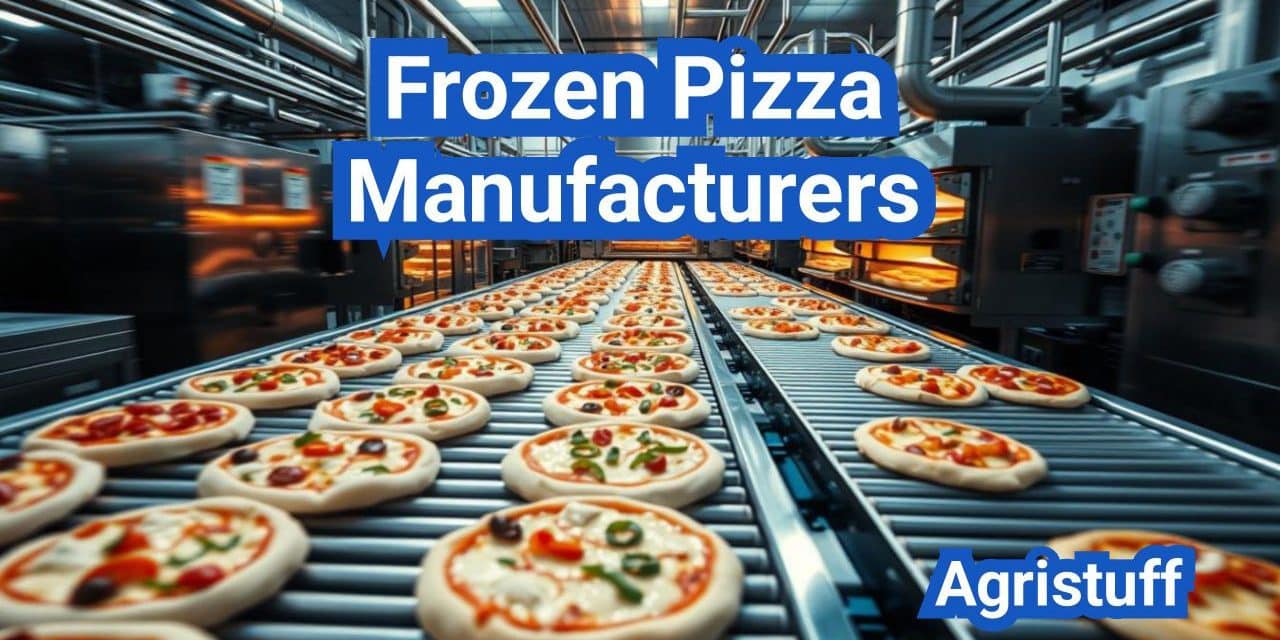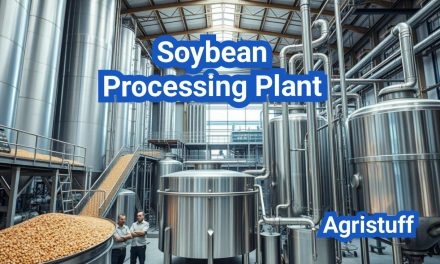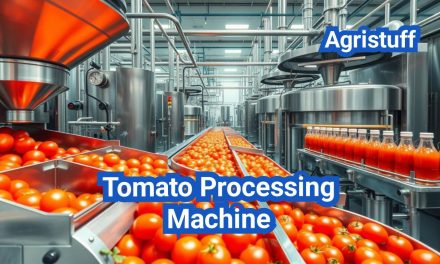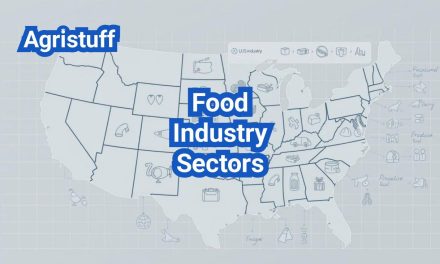The frozen pizza industry has experienced significant growth in recent years, driven by consumer demand for convenient and affordable meals. Frozen pizza manufacturers play a crucial role in this industry, producing a wide range of products that cater to diverse consumer preferences.
These manufacturers utilize advanced production lines, including dough preparation, topping, and freezing methods, to create high-quality frozen pizzas. The industry’s growth is expected to continue, with companies innovating and expanding their product lines to meet changing consumer needs.
Key Takeaways
- The frozen pizza industry has seen significant growth due to consumer demand for convenience.
- Frozen pizza manufacturers produce a wide range of products catering to diverse consumer preferences.
- Advanced production lines, including dough preparation and freezing methods, are used to create high-quality products.
- The industry is expected to continue growing with companies innovating and expanding their product lines.
- Consumer preferences are driving the demand for diverse and high-quality frozen pizzas.
The Frozen Pizza Industry Overview
With a market value of USD 19.6 billion in 2019, the frozen pizza industry is a substantial segment of the global food market. The industry’s growth is driven by increasing consumer demand for convenient and affordable meal options.
Market Size and Growth Trends
The frozen pizza market has been steadily expanding, with growth trends indicating a continued increase in demand. Factors contributing to this growth include busy lifestyles, an increase in single-person households, and advancements in freezing technology that preserve the quality of pizzas.
According to market research, the global frozen pizza market is expected to continue its growth trajectory, driven by innovations in product offerings and packaging. The rise of premium and gourmet frozen pizzas has also contributed to market expansion, as consumers are willing to pay more for high-quality ingredients and unique flavor profiles.
Consumer Demand Patterns
Consumer demand patterns in the frozen pizza industry are influenced by various factors, including taste preferences, dietary restrictions, and convenience. There is a growing trend towards healthier options, with consumers seeking pizzas with whole-wheat crusts, lower sodium content, and organic ingredients.
The demand for personalized and customizable frozen pizzas is also on the rise, with consumers looking for products that allow them to tailor toppings and ingredients to their preferences.
Impact of Economic Factors on Production
Economic factors significantly impact the production and pricing of frozen pizzas. Fluctuations in commodity prices, such as wheat, cheese, and tomato sauce, can affect production costs. Additionally, changes in energy costs and labor expenses can influence the overall cost of manufacturing frozen pizzas.
Manufacturers often respond to these economic pressures by optimizing production processes, investing in energy-efficient equipment, and renegotiating contracts with suppliers to maintain profitability.
Leading Frozen Pizza Manufacturers in the USA

The USA is home to numerous prominent frozen pizza manufacturers, offering a wide range of products that cater to diverse consumer preferences.
Major Commercial Brands
Major commercial brands play a significant role in the frozen pizza market. Digiorno and Newman’s Own are two of the most recognized names, known for their high-quality products and innovative flavors.
Digiorno, a brand owned by Nestle, is famous for its rising crust pizzas, which have become a staple in many American households. Newman’s Own, on the other hand, is recognized for its commitment to using high-quality, natural ingredients.
| Brand | Notable Product | Key Feature |
|---|---|---|
| Digiorno | Rising Crust Pizza | Innovative crust technology |
| Newman’s Own | Organic Thin Crust | Use of natural ingredients |
Specialty Manufacturers
In addition to major commercial brands, specialty manufacturers like Miracapo Pizza Company and Lucia’s Pizza offer unique products that cater to niche markets.
Miracapo Pizza Company is known for its artisanal approach to frozen pizza, using high-end ingredients to create gourmet-style pizzas. Lucia’s Pizza, on the other hand, offers traditional Italian-style pizzas with a focus on authenticity.
Frozen Specialties, Inc. and Other Key Players
Frozen Specialties, Inc. is another significant player in the industry, providing a range of frozen pizza products to both retail and foodservice sectors.
Other key players in the market include companies that specialize in private label manufacturing, offering customized frozen pizza solutions for retailers.
The diversity among leading frozen pizza manufacturers in the USA contributes to a vibrant market with a wide range of choices for consumers.
Setting Up a Frozen Pizza Manufacturing Operation
To successfully launch a frozen pizza manufacturing operation, careful consideration of multiple factors is necessary. This includes understanding the intricacies of production planning, facility layout, and equipment requirements.
Facility Requirements and Layout Planning
The design and layout of a frozen pizza manufacturing facility are critical to efficient production. The facility must be designed to accommodate the production line, storage for raw materials and finished goods, and employee amenities. A well-planned facility layout can significantly enhance productivity and reduce operational costs.
Key considerations for facility planning include ensuring adequate space for equipment, maintaining a clean and sanitary environment, and complying with food safety regulations. The layout should facilitate a smooth workflow, minimizing the risk of cross-contamination and ensuring that products move efficiently through the production process.
Equipment Selection and Investment Considerations
Selecting the right equipment is crucial for frozen pizza manufacturing. This includes mixers, dough sheeters, topping applicators, and freezing tunnels. The choice of equipment depends on the production volume, product variety, and available capital investment.
When evaluating equipment options, manufacturers should consider factors such as energy efficiency, maintenance requirements, and compatibility with existing production lines. Investing in high-quality equipment can lead to long-term cost savings and improved product quality.
- Assess production needs and volume requirements.
- Evaluate equipment specifications and compatibility.
- Consider energy efficiency and operational costs.
Staffing and Training Requirements
Adequate staffing and training are essential for the success of a frozen pizza manufacturing operation. Employees should be trained in production techniques, food safety practices, and equipment operation.
Effective training programs can enhance productivity, reduce waste, and ensure compliance with regulatory requirements. Manufacturers should invest in ongoing training and development to maintain a skilled workforce.
Frozen Pizza Dough Production Technologies
Advanced dough production technologies are essential for creating the perfect frozen pizza crust. The process involves several critical steps, from mixing and sheeting to par-baking, each requiring precise machinery and control.
Dough Mixing Systems and Equipment
The initial step in frozen pizza dough production is mixing, where ingredients are combined to form a uniform dough. High-capacity mixers are used to handle large batches, ensuring consistency and quality. The choice of mixer can significantly impact dough development, with some manufacturers opting for high-shear mixers to achieve specific dough characteristics.
“The right mixer can make all the difference in dough quality,” notes an industry expert. “It’s not just about combining ingredients; it’s about creating a dough that will perform well through the freezing and baking processes.”
Pizza Dough Sheeting Techniques
After mixing, the dough is sheeted to the desired thickness. This process requires careful control to ensure uniformity across the dough sheet. Advanced sheeting lines are equipped with sophisticated controls to adjust thickness and tension, minimizing waste and optimizing dough yield.
- Precision thickness control
- Adjustable sheeting speeds
- Automated tension control
Par-Baking Processes and Equipment
Par-baking is a critical step that partially bakes the dough before freezing, enhancing crust texture and flavor. Par-baking ovens are designed to provide consistent heat control, crucial for achieving the right level of doneness without overcooking the crust.
The benefits of par-baking include improved crust texture and reduced baking time for consumers. As one manufacturer notes, “Par-baking gives our pizzas a fresh-baked taste and texture, even after freezing.”
By leveraging these advanced dough production technologies, manufacturers can produce high-quality frozen pizzas that meet consumer expectations for taste, texture, and convenience.
Frozen Pizza Base Options and Innovations

The frozen pizza market has witnessed a significant shift in consumer preferences, driving innovation in pizza base options. As a result, manufacturers are now offering a diverse range of pizza bases to cater to various tastes and dietary requirements.
Traditional vs. Specialty Crusts
Traditional pizza crusts remain a staple in the frozen pizza market, but there’s a growing demand for specialty crusts that offer unique flavors and textures. Specialty crusts, such as garlic parmesan, whole wheat, or crusts infused with herbs, are becoming increasingly popular among consumers looking for a more gourmet experience at home.
The rise of specialty crusts has led manufacturers to innovate and expand their product lines. For instance, some companies are introducing crusts with ancient grains or crusts that are high in protein, catering to the health-conscious consumer.
Gluten-Free and Alternative Bases
The demand for gluten-free and alternative bases is on the rise, driven by consumers with dietary restrictions or preferences. Gluten-free pizza bases made from ingredients like rice flour, corn flour, or cauliflower are becoming more prevalent. Additionally, alternative bases such as cauliflower crusts or crusts made from other vegetables are gaining popularity for their perceived health benefits.
Manufacturers are responding to this trend by developing a range of gluten-free and alternative base options that do not compromise on taste or texture. This includes using innovative ingredients and production techniques to create bases that are not only gluten-free but also appealing to a broad consumer base.
Pre-Formed Frozen Pizza Bases Suppliers
For manufacturers looking to streamline their production processes, pre-formed frozen pizza bases offer a convenient solution. Suppliers of pre-formed bases provide a range of options, from traditional to gluten-free and specialty crusts, allowing manufacturers to focus on topping and final product assembly.
The use of pre-formed bases can significantly reduce production time and costs, making it an attractive option for businesses looking to expand their frozen pizza offerings without heavily investing in dough preparation infrastructure.
Topping Application Systems for Frozen Pizza Production Lines
In the frozen pizza industry, topping application systems play a critical role in determining the final product’s taste, texture, and appearance. Efficient and accurate topping application is essential for maintaining product quality and consistency.
Sauce Depositing Equipment
Sauce depositing is a fundamental aspect of topping application. Modern sauce depositing equipment allows for precise control over the amount and distribution of sauce on the pizza base. This not only ensures consistency but also helps in maintaining the desired flavor profile.
Key Features of Sauce Depositing Equipment:
- Adjustable sauce volume control
- Uniform distribution systems
- Easy cleaning and maintenance
Cheese Application Technologies
Cheese is a primary topping for pizzas, and its application requires specialized technologies. Cheese application systems are designed to distribute cheese evenly across the pizza, ensuring that every slice has the right amount of cheese.
Advantages of Advanced Cheese Application:
- Consistent cheese distribution
- Reduced cheese waste
- Improved product appearance
Topping Distribution Systems and Optimization
Topping distribution systems are crucial for applying various toppings, such as vegetables, meats, and herbs, onto frozen pizzas. These systems are designed to optimize the topping application process, ensuring that toppings are evenly distributed and that the product meets the desired specifications.
Optimization Techniques:
- Adjusting topping dispensing rates
- Implementing vision inspection systems
- Utilizing data analytics for process improvement
By leveraging advanced topping application systems, frozen pizza manufacturers can enhance product quality, reduce production costs, and improve overall efficiency.
IQF Toppings for Pizza: Processing and Benefits

The use of Individual Quick Freezing (IQF) toppings has revolutionized the frozen pizza industry by preserving the quality and freshness of ingredients. IQF toppings are a popular choice among frozen pizza manufacturers due to their ability to maintain texture and flavor.
Individual Quick Freezing Technology
Individual Quick Freezing (IQF) technology involves rapidly freezing individual pieces of food, such as vegetables, meats, or herbs, to preserve their quality. This method prevents the formation of ice crystals between food particles, thereby maintaining the texture and integrity of the ingredients.
The IQF process typically involves:
- Pre-cooling the ingredients to remove excess heat
- Rapid freezing using cold air or liquid nitrogen
- Storage at very low temperatures to maintain quality
Quality Preservation of IQF Ingredients
IQF ingredients offer several quality preservation benefits, including:
- Retention of nutritional value due to minimal processing and quick freezing
- Preservation of texture and flavor through the prevention of ice crystal formation
- Reduced risk of freezer burn due to individual freezing
These benefits make IQF toppings highly desirable for frozen pizza production, as they contribute to a more authentic and satisfying consumer experience.
Popular IQF Toppings for Frozen Pizzas
Some of the most popular IQF toppings used in frozen pizzas include:
- IQF vegetables such as bell peppers, onions, and mushrooms
- IQF meats like pepperoni, sausage, and bacon
- IQF herbs and spices for added flavor
These IQF toppings not only enhance the flavor and texture of frozen pizzas but also provide manufacturers with a convenient and consistent supply of high-quality ingredients.
Frozen Pizza Freezing Methods and Equipment
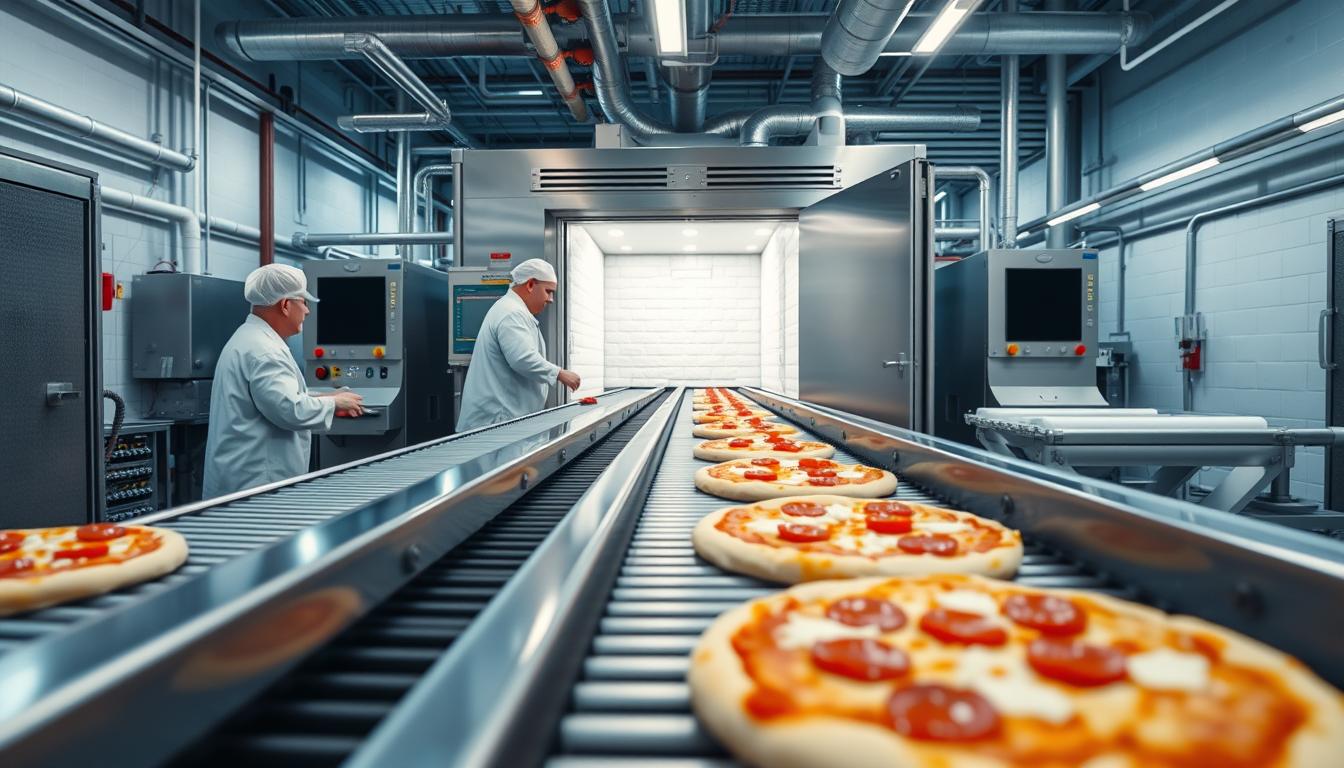
Effective freezing is crucial in frozen pizza production, impacting both quality and shelf life. The freezing process helps preserve the texture, flavor, and nutritional value of the pizza. Various freezing methods are employed in the industry, each with its advantages and specific applications.
Spiral Freezers for Pizza Production
Spiral freezers are widely used in frozen pizza production due to their efficiency and effectiveness. These freezers feature a continuous spiral belt that allows for high-volume freezing. The compact design of spiral freezers makes them ideal for facilities with limited space.
Key benefits of spiral freezers include:
- High capacity freezing
- Compact footprint
- Energy efficiency
- Flexibility in handling various product sizes
Tunnel Freezing Systems
Tunnel freezing systems are another common method used in frozen pizza production. These systems involve a conveyor belt that moves the pizzas through a cold tunnel, where they are exposed to freezing temperatures.
Tunnel freezing offers several advantages:
- Continuous freezing process
- Even freezing due to controlled air circulation
- Flexibility in configuring tunnel length and conveyor speed
| Freezing Method | Capacity | Energy Efficiency | Space Requirements |
|---|---|---|---|
| Spiral Freezers | High | High | Compact |
| Tunnel Freezing | Variable | Medium | Variable |
| Cryogenic Freezing | High | Low | Compact |
Cryogenic Freezing Options and Efficiency
Cryogenic freezing involves the use of extremely low temperatures, typically achieved with liquid nitrogen or liquid carbon dioxide, to rapidly freeze pizzas. This method is known for its speed and ability to preserve product quality.
Advantages of cryogenic freezing:
- Rapid freezing
- High product quality retention
- Flexibility in production volume
In conclusion, the choice of freezing method in frozen pizza production depends on factors such as production volume, available space, and energy efficiency considerations. Manufacturers must weigh these factors to select the most appropriate freezing technology for their operations.
Sanitary Design in Frozen Pizza Manufacturing Equipment

Ensuring sanitary design in manufacturing equipment is vital for the production of safe frozen pizzas. Sanitary design refers to the design and construction of equipment and facilities to prevent product contamination and ensure easy cleaning and maintenance.
Food Safety Requirements for Production Lines
Food safety is paramount in frozen pizza manufacturing. Production lines must be designed to minimize the risk of contamination. This includes using equipment that is easy to clean and sanitize, and designing the production line to prevent the accumulation of debris and bacteria.
Key food safety requirements include:
- Easy-to-clean equipment surfaces
- Prevention of standing water
- Minimize crevices and corners where debris can accumulate
- Use of sanitary materials for equipment construction
Cleaning and Sanitization Protocols
Effective cleaning and sanitization protocols are crucial for maintaining sanitary conditions in frozen pizza manufacturing. This involves regular cleaning schedules, proper use of cleaning agents, and sanitization techniques to eliminate bacteria and other pathogens.
| Cleaning Protocol | Frequency | Responsible Personnel |
|---|---|---|
| Daily Sanitation | After every production run | Cleaning Crew |
| Deep Cleaning | Weekly | Maintenance Team |
| Sterilization of Equipment | Monthly | Quality Assurance Team |
Equipment Material Considerations
The materials used for manufacturing equipment can significantly impact sanitary design. Equipment should be constructed from materials that are durable, non-toxic, and resistant to corrosion.
Common materials used include stainless steel, certain plastics, and other food-grade materials. The choice of material depends on the specific application, including the type of product being manufactured and the operating conditions of the equipment.
Regulatory Compliance for Frozen Pizza Manufacturers

Frozen pizza manufacturers must navigate a complex regulatory landscape to ensure compliance with food safety standards. The production and distribution of frozen pizzas are subject to various regulations that govern food safety, labeling, and packaging.
FSMA Preventive Controls Implementation
The Food Safety Modernization Act (FSMA) requires frozen pizza manufacturers to implement preventive controls to minimize the risk of contamination. This includes developing a written food safety plan that outlines the procedures for identifying and controlling hazards.
Preventive controls may include:
- Implementing sanitation procedures for equipment and facilities
- Conducting regular supplier verification activities
- Establishing a recall plan in case of contamination
NRTE Pizza Labeling Requirements
Not Ready-to-Eat (NRTE) pizzas must be labeled in compliance with FDA regulations. The label must include a clear statement of the product’s identity, net weight, and any required nutrition labeling.
NRTE pizza labels must also comply with regulations related to:
- Allergen labeling
- Nutrition facts
- Safe handling instructions
Food Allergen Labeling and GS1 UPC Standards
Frozen pizza manufacturers must comply with food allergen labeling regulations, which require the disclosure of major food allergens on the product label. The use of GS1 Universal Product Code (UPC) standards ensures that products are accurately identified and tracked throughout the supply chain.
Compliance with these regulations is critical to ensuring consumer safety and avoiding costly penalties. By implementing preventive controls, accurate labeling, and GS1 UPC standards, frozen pizza manufacturers can maintain regulatory compliance and build consumer trust.
Quality Assurance in Frozen Pizza Production
To guarantee the quality and safety of frozen pizzas, manufacturers must implement robust quality assurance protocols. Quality assurance is critical in ensuring that products meet the required safety and quality standards.
Testing Protocols and Standards
Testing protocols are essential in verifying that frozen pizzas comply with regulatory requirements and industry standards. Manufacturers should establish rigorous testing procedures to check for product quality, texture, and safety. This includes microbiological testing, texture analysis, and sensory evaluation.
Microbiological testing is crucial in detecting potential contamination and ensuring that products are safe for consumption. Texture analysis helps in assessing the pizza’s crust, sauce, and topping quality.
Shelf-Life Validation Methods
Shelf-life validation is vital in determining the product’s durability and safety over time. Manufacturers should conduct regular shelf-life studies to assess the product’s quality and safety at various stages of storage and transportation.
- Storage at different temperatures to simulate real-world conditions
- Regular sampling and testing at predetermined intervals
- Assessment of packaging integrity and its impact on product quality
Sensory Evaluation Techniques
Sensory evaluation is a critical component of quality assurance, as it assesses the product’s appearance, taste, texture, and overall acceptability. Trained sensory panels can provide valuable insights into product quality and help identify areas for improvement.
Sensory evaluation techniques include descriptive analysis, hedonic testing, and triangle testing. These methods help manufacturers understand consumer preferences and optimize their products accordingly.
By implementing comprehensive quality assurance protocols, including testing protocols, shelf-life validation, and sensory evaluation, frozen pizza manufacturers can ensure the production of high-quality, safe products that meet consumer expectations.
Cold Chain Management for Frozen Pizza Distribution

Cold chain management plays a vital role in ensuring that frozen pizzas remain safe and of high quality during distribution. This involves a series of coordinated actions to maintain the required low temperatures throughout the supply chain, from the manufacturing facility to the retailer’s freezer.
Temperature Monitoring Systems
Temperature monitoring is a critical component of cold chain management. Advanced temperature monitoring systems utilize sensors and real-time data logging to track the temperature of frozen pizzas throughout the distribution process. These systems can alert logistics managers to any temperature deviations, enabling prompt corrective action.
Key Features of Temperature Monitoring Systems:
- Real-time temperature tracking
- Automated alerts for temperature deviations
- Data logging for compliance and quality control
- Integration with logistics management software
According to industry experts, “Temperature monitoring is not just about compliance; it’s about ensuring the quality and safety of the product.”
“The use of temperature monitoring systems has become increasingly important in the frozen food industry, as it helps to prevent temperature-related quality issues and ensures regulatory compliance.”
Transportation Considerations
Transportation is a critical link in the cold chain. Frozen pizzas must be transported in refrigerated vehicles that are capable of maintaining the required low temperatures. The transportation process should be planned to minimize transit times and avoid exposure to temperature fluctuations.
| Transportation Mode | Temperature Control | Transit Time |
|---|---|---|
| Refrigerated Trucks | -20°C to -15°C | 24 to 48 hours |
| Air Freight | -20°C to -15°C | 2 to 6 hours |
| Intermodal | -20°C to -15°C | Varies |
Warehouse Storage Requirements
Warehouse storage is another crucial aspect of cold chain management. Frozen pizzas must be stored in freezers that maintain a consistent temperature below -15°C. Warehouses should be equipped with backup power systems and temperature monitoring equipment to ensure that storage conditions are maintained even in the event of a power outage.
Effective cold chain management requires careful planning, precise temperature control, and continuous monitoring. By implementing robust cold chain management practices, frozen pizza distributors can ensure that their products remain safe and of high quality throughout the distribution process.
Private Label Opportunities in the Frozen Pizza Market

The frozen pizza market is witnessing a significant surge in private label opportunities, driven by retailers seeking to establish their own branded products. This trend is driven by consumer demand for affordable, high-quality frozen pizzas.
Co-Packing Partnerships with Established Manufacturers
One of the key strategies for retailers to enter the private label frozen pizza market is through co-packing partnerships with established manufacturers. These partnerships allow retailers to leverage the expertise and production capabilities of experienced manufacturers.
Co-packing partnerships offer several benefits, including reduced production costs, improved product quality, and faster time-to-market. Retailers can capitalize on the manufacturer’s existing infrastructure and expertise, enabling them to launch their private label products quickly.
| Benefits | Description |
|---|---|
| Reduced Production Costs | Lower costs due to economies of scale and existing infrastructure |
| Improved Product Quality | Expertise of established manufacturers ensures high-quality products |
| Faster Time-to-Market | Quick launch of private label products leveraging existing production capabilities |
Custom Formulation Services
Custom formulation services are another critical aspect of private label frozen pizza production. Manufacturers offering these services can help retailers create unique products that differentiate their brand in the market.
Custom formulation involves tailoring the pizza recipe, toppings, and seasonings to meet the retailer’s specifications. This can include creating gluten-free, vegan, or other specialty pizzas that cater to specific consumer preferences.
Branding and Packaging Considerations
Effective branding and packaging are crucial for the success of private label frozen pizzas. Retailers must create an appealing brand identity and packaging that resonates with their target audience.
Key considerations include the design of the packaging, labeling, and branding elements that align with the retailer’s overall brand strategy. The packaging should be visually appealing, convey the product’s value proposition, and comply with regulatory requirements.
By focusing on co-packing partnerships, custom formulation services, and branding and packaging considerations, retailers can successfully launch and grow their private label frozen pizza offerings in a competitive market.
Future Trends in Frozen Pizza Manufacturing
The frozen pizza industry is poised for continued growth, driven by consumer demand for convenient and affordable meal options. As manufacturers look to the future, emerging technologies will play a crucial role in shaping the industry’s outlook.
Advancements in frozen pizza manufacturing, such as improved freezing methods and topping application systems, are expected to enhance product quality and efficiency. The adoption of innovative technologies, including automation and data analytics, will also contribute to the industry’s evolution.
Future trends in frozen pizza manufacturing will likely be influenced by changing consumer preferences, including the demand for healthier and more sustainable products. Manufacturers will need to adapt to these trends by developing new products and production processes that meet evolving consumer needs.
As the industry continues to grow and evolve, companies that invest in emerging technologies and prioritize product quality and innovation are likely to remain competitive in the market.
FAQ
What is the market size of the frozen pizza industry?
The frozen pizza industry is a significant segment of the global food market, with a steadily increasing market size driven by consumer demand for easy-to-prepare meals.
Who are the leading frozen pizza manufacturers in the USA?
The USA is home to several prominent frozen pizza manufacturers, including Digiorno and Newman’s Own, which are well-established brands in the market.
What are the key considerations for setting up a frozen pizza manufacturing operation?
Setting up a frozen pizza manufacturing operation requires careful planning and execution, including facility requirements, equipment selection, and staffing needs.
What technologies are used in frozen pizza dough production?
Frozen pizza dough production involves precise technologies, including mixing systems, sheeting techniques, and par-baking processes, to produce high-quality dough.
What are the different frozen pizza base options available?
The frozen pizza market offers a range of base options, including traditional and specialty crusts, gluten-free and alternative bases, and pre-formed bases.
How are toppings applied to frozen pizzas?
Topping application is a crucial step in frozen pizza production, involving accurate and efficient systems, including sauce depositing equipment, cheese application technologies, and topping distribution systems.
What are IQF toppings, and what are their benefits?
IQF toppings are a popular choice for frozen pizzas, offering preserved quality and freshness, and are processed using individual quick freezing technology.
What freezing methods are used in frozen pizza production?
Freezing is a critical step in frozen pizza production, involving efficient and effective methods, including spiral freezers, tunnel freezing systems, and cryogenic freezing options.
Why is sanitary design important in frozen pizza manufacturing equipment?
Sanitary design is essential in frozen pizza manufacturing to prevent contamination and ensure product safety, involving food safety requirements, cleaning protocols, and equipment material considerations.
What regulations must frozen pizza manufacturers comply with?
Frozen pizza manufacturers must comply with various regulations, including FSMA preventive controls, NRTE pizza labeling, and food allergen labeling, to ensure product safety and labeling accuracy.
How is quality assurance achieved in frozen pizza production?
Quality assurance is essential in frozen pizza production, involving testing protocols, shelf-life validation, and sensory evaluation techniques to ensure consistent product quality and safety.
What is cold chain management, and why is it important for frozen pizza distribution?
Cold chain management is critical to maintaining the quality and safety of frozen pizzas during distribution, involving temperature monitoring systems, transportation considerations, and warehouse storage requirements.
What are private label opportunities in the frozen pizza market?
Private label opportunities are increasing in the frozen pizza market, driven by retailer demand for branded products, involving co-packing partnerships, custom formulation services, and branding and packaging considerations.
Conclusion of: Frozen Pizza Manufacturers In USA
Why frozen pizza manufacturers matter in the U.S. food system
Frozen pizza manufacturers power a category that blends food science, safety, and retail execution at scale. From controlled dough rooms to high-speed topping lines and validated freezing tunnels, frozen pizza manufacturers must deliver consistent quality that survives the cold chain and bakes reliably at home. In the U.S., freezer storage targets, labeling, and handling practices shape every step from plant to shopper, so mastering the process is essential for growth. FDA freezer-safety guidance (0°F/-18°C)
Regulatory framework: what frozen pizza manufacturers must build into operations
Frozen pizza manufacturers operate under Current Good Manufacturing Practice (CGMP) with risk-based preventive controls, which require documented sanitation, equipment hygiene, allergen management, training, supplier verification, and meticulous records. In practice, frozen pizza manufacturers validate cleaning for mixers and sheeters, monitor ingredient receiving, and control post-bake handling to prevent recontamination. 21 CFR Part 117 (CGMP & Preventive Controls)
Who regulates what: FDA vs. FSIS for frozen pizza manufacturers
Jurisdiction for frozen pizza manufacturers depends on toppings: cheese-only or veggie pizzas are generally FDA-regulated, while meat or poultry above defined thresholds brings USDA FSIS oversight. This affects inspection style, labeling approvals, and recordkeeping. Many frozen pizza manufacturers maintain dual competence when portfolios include both FDA and FSIS items. FSIS Food Standards & Labeling Policy Book (pizza thresholds)
Dough formulation: where frozen pizza manufacturers set texture and crisp
Crust quality for frozen pizza manufacturers hinges on flour protein, hydration, yeast, salt, oil, and fermentation time/temperature. To meet CGMP expectations, frozen pizza manufacturers track dough temperature leaving the mixer, manage bulk or ball rest, and standardize sheeting conditions so crust performance survives freeze–thaw cycles. CGMP process & control requirements (Subpart B)
Sheeting and pressing: how frozen pizza manufacturers get uniform bases
To hit target diameter and gram weight at speed, frozen pizza manufacturers use industrial sheeting or press systems that reduce dough in stages, control thickness, and enable fast sanitation. Recipe-driven set-points and hygienic design let frozen pizza manufacturers minimize downtime and variability. Industrial dough sheeting & laminating overview
Par-baking and ovens: the thermal profile frozen pizza manufacturers need
Many frozen pizza manufacturers par-bake crusts to stabilize structure before topping, using impingement or stone-style ovens to manage moisture and set crumb. Validated time–temperature profiles help frozen pizza manufacturers lock in crispness while preventing over-drying before freezing. Industrial impingement oven process basics
Sauce application: accuracy that frozen pizza manufacturers rely on
A consistent sauce spiral is more than aesthetics: frozen pizza manufacturers deploy volumetric or nozzle applicators to hit target grams, keep rims clean, and support accurate nutrition labels. Closed-loop controls reduce waste and improve yield for frozen pizza manufacturers. Industrial sauce & topping applicator specs
Cheese and vegetable dosing: why frozen pizza manufacturers choose waterfall systems
For speed and uniformity, frozen pizza manufacturers use waterfall applicators for shredded cheese and IQF vegetables, with reclaim conveyors and feedback control to maintain weights. Border-free options keep the rim clear, improving bake for frozen pizza manufacturers. Waterfall topping applicator (industrial spec)
Meat portioning: precision for frozen pizza manufacturers
When using pepperoni or sausage, frozen pizza manufacturers depend on inline slicers and dicers that deliver uniform cuts matching label claims and distribution specs. Consistency protects cost and consumer experience for frozen pizza manufacturers. Pepperoni cutting & portioning applications
Allergens and cross-contact: a critical plan for frozen pizza manufacturers
Because crusts contain wheat, cheeses contain milk, and sauces or toppings may include soy or sesame, frozen pizza manufacturers must prevent allergen cross-contact via dedicated tools, controlled changeovers, validated cleaning, and label control. Sesame’s inclusion as a major U.S. allergen requires correct declaration by frozen pizza manufacturers. FDA update: sesame as a major allergen
Labeling basics: what frozen pizza manufacturers must print
Frozen pizza manufacturers ensure compliant ingredient lists by weight, allergen statements, Nutrition Facts, net weight, and clear handling/cooking instructions. Harmonizing labels across FDA and FSIS items helps frozen pizza manufacturers reduce errors and audit friction. FDA Food Labeling Guide (PDF)
NRTE instructions and lethality: the consumer bake still matters to frozen pizza manufacturers
Most products are not-ready-to-eat (NRTE), so frozen pizza manufacturers validate oven instructions for home conditions to achieve safety and quality. For pre-cooked meat toppings, frozen pizza manufacturers also validate upstream lethality and protect from post-lethality contamination. FSIS cooking/lethality guidance
Freezing physics 101: what frozen pizza manufacturers manage
Rapidly crossing the maximum ice-crystal growth zone preserves structure. Frozen pizza manufacturers engineer airflow, belt load, and dwell time so crusts stay crisp, cheese stretches, and veggies avoid mushiness after bake. FAO primer on food freezing
IQF vs. block: how frozen pizza manufacturers handle toppings
Individually Quick Frozen (IQF) ingredients stay separate for even distribution and consistent weights, while block-frozen items can clump. For high-speed lines and accurate nutritionals, frozen pizza manufacturers favor IQF cheese, veg, and proteins. International Institute of Refrigeration: cryogenic nitrogen
Freezer choices: what frozen pizza manufacturers weigh (spiral vs. cryogenic)
Mechanical spiral freezers offer high throughput and strong total cost at scale; cryogenic tunnels using liquid nitrogen or CO₂ deliver fast pull-down and flexibility. Frozen pizza manufacturers pick based on capacity, SKU mix, footprint, and OPEX. LN₂ vs. CO₂ freezing overview
Packaging materials: barriers and compliance for frozen pizza manufacturers
Moisture and oxygen barriers protect quality during distribution, and food-contact compliance is mandatory. Frozen pizza manufacturers select films and boards approved for food contact and validate sealing to resist freezer abuse. FDA: Food-contact substances program
Cold storage targets: what frozen pizza manufacturers lock in
For safety, frozen pizza manufacturers hold finished goods at 0°F (-18°C) or below. While quality can decline, food remains safe at this temperature when handled properly, so frozen pizza manufacturers monitor temperatures and door cycles to protect texture and flavor. USDA FSIS: freezing & food safety
Transportation: how frozen pizza manufacturers stay FSMA-compliant
The Sanitary Transportation rule requires suitable equipment, temperature control, and documentation. Frozen pizza manufacturers specify pre-cool, in-transit monitoring, and data logs to meet retailer and audit requirements. FSMA Sanitary Transportation rule
Retail readiness: barcodes and data that frozen pizza manufacturers must manage
To flow through U.S. retail, frozen pizza manufacturers assign valid GTIN/UPC codes and follow GS1 standards so scanners and warehouses recognize each variant and pack size. Clean item data reduces chargebacks for frozen pizza manufacturers. GS1 US: getting UPC barcodes
Quality and shelf-life testing: what frozen pizza manufacturers validate
Frozen pizza manufacturers run sensory, moisture, water activity, and bake tests to confirm target texture, melt, and flavor through shelf life. Controls for moisture migration and ice crystallization help frozen pizza manufacturers maintain consistent consumer outcomes. IFT: shelf-life testing overview
Statistical control and OEE: how frozen pizza manufacturers optimize lines
Using SPC on weights, diameters, and thermal profiles helps frozen pizza manufacturers cut giveaway and reduce complaints. Overall Equipment Effectiveness dashboards guide frozen pizza manufacturers on bottlenecks and planned vs. unplanned downtime. NIST Engineering Statistics Handbook
Foreign-material prevention: must-have for frozen pizza manufacturers
Magnets, sieves, metal detectors, and X-ray systems control physical hazards, but supplier controls and maintenance matter too. Frozen pizza manufacturers document programs and corrective actions because even tiny fragments can trigger regulatory action. FDA CPG 555.425 on foreign objects
Environmental monitoring: how frozen pizza manufacturers manage Listeria risk
Post-bake areas are sensitive; if products are RTE at pack, Listeria monocytogenes must be controlled through sanitation and environmental monitoring. Even for NRTE items, frozen pizza manufacturers swab zones, trend results, and act on positives to protect brand trust. FDA guidance on controlling Listeria
Food defense: the protection plan frozen pizza manufacturers need
Beyond food safety, frozen pizza manufacturers implement food-defense measures against intentional adulteration—assessing vulnerabilities, securing access, and training teams per the IA Rule. Documentation shows frozen pizza manufacturers have preventive steps in place. FDA Intentional Adulteration (IA) Rule
Ammonia refrigeration & safety: what frozen pizza manufacturers must manage
Large cold plants often use anhydrous ammonia systems; frozen pizza manufacturers train staff, maintain detectors, and plan emergency response. OSHA resources help frozen pizza manufacturers assess PSM elements and safe operations. OSHA: Ammonia refrigeration eTool
Traceability & recall readiness: how frozen pizza manufacturers prove control
From ingredient lots to finished pallets, frozen pizza manufacturers maintain batch records, calibrations, allergen changeovers, and shipping temperatures. Enhanced traceability expectations push frozen pizza manufacturers to improve data capture for faster, more precise recalls. FDA Food Traceability Final Rule (FSMA 204)
Co-manufacturing & scale: options for emerging frozen pizza manufacturers
New brands often start with co-manufacturers to access sheeters, impingement ovens, and freezers without heavy capex. Clear specs and robust quality agreements help frozen pizza manufacturers grow SKUs and retail distribution while protecting consistency. CPA: Association for Contract Packagers & Manufacturers
Sustainability and waste reduction: priorities for frozen pizza manufacturers
Reducing dough trim, reclaiming cheese, and optimizing packaging are quick wins for frozen pizza manufacturers. Donation, diversion, and prevention strategies help frozen pizza manufacturers cut waste across the supply chain. EPA Food Recovery Hierarchy
Final thought
Winning in the frozen aisle takes more than tasty toppings—it’s the orchestration of preventive controls, accurate dosing, fast freezing, bulletproof cold chain, and retail data hygiene. Frozen pizza manufacturers that master these disciplines earn retailer trust, delight consumers, and scale sustainably in the U.S. market. Review CGMP/Preventive Controls requirements
Sources & References
- 21 CFR Part 117 (CGMP & Preventive Controls)
- FDA: freezer-safety guidance (0°F)
- USDA FSIS: Freezing & Food Safety
- FDA: FSMA Sanitary Transportation Rule
- FDA Food Labeling Guide (PDF)
- FDA: Sesame as a major allergen
- FSIS Food Standards & Labeling Policy Book
- FSIS: Cooking/Lethality Guidance
- FAO: Food freezing fundamentals
- International Institute of Refrigeration: Cryogenic nitrogen
- Matheson: LN₂ vs. CO₂ in food freezing
- AMF: Dough sheeting & laminating
- Grote: Sauce & topping applicators
- Urschel: Pepperoni cutting applications
- BAKERpedia: Impingement oven
- FDA: Food-contact substances
- GS1 US: UPC barcodes
- IFT: Shelf-life testing overview
- NIST: Engineering Statistics Handbook
- FDA CPG 555.425: Foreign objects
- FDA: Listeria control in RTE foods
- OSHA: Ammonia refrigeration
- CPA: Contract Packagers & Manufacturers
- EPA: Food Recovery Hierarchy

